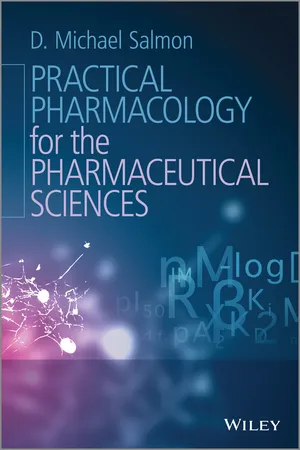
- English
- ePUB (mobile friendly)
- Available on iOS & Android
Practical Pharmacology for the Pharmaceutical Sciences
About this book
Practical Pharmacology for the Pharmaceutical Sciences is a lab survival guide for those studying Pharmacology, providing hands-on advice on developing pharmacology laboratory and data handling skills. Suitable for both undergraduates and postgraduates, it focuses on laboratory techniques rather than computer-simulated data. It also guides the reader through the process of communicating experimental results in a variety of formats, including posters, oral presentations and project reports.
Split into three main areas, the following topics are covered in detail:
Preparation for Experimental Pharmacology
- Legal aspects
- Fundamentals of Pharmacology
- Definitions, calculations and statistics
Experiments in Pharmacology
- Microtitre-based techniques using isolated cells
- In vitro techniques using isolated tissues and organs
- Biochemical techniques using cell-free systems
Communicating experimental results
- Data presentation
- How to write scientific reports
- Pharmacological literature
Supported with numerous questions throughout the text, as well as step by step instructions for practical experiments, this book presents an approach to learning pharmacology through an appreciation of authentic experimental data.
Frequently asked questions
- Essential is ideal for learners and professionals who enjoy exploring a wide range of subjects. Access the Essential Library with 800,000+ trusted titles and best-sellers across business, personal growth, and the humanities. Includes unlimited reading time and Standard Read Aloud voice.
- Complete: Perfect for advanced learners and researchers needing full, unrestricted access. Unlock 1.4M+ books across hundreds of subjects, including academic and specialized titles. The Complete Plan also includes advanced features like Premium Read Aloud and Research Assistant.
Please note we cannot support devices running on iOS 13 and Android 7 or earlier. Learn more about using the app.
Information
- What are the dangers of handling individual chemicals? These are shown on data sheets supplied by chemical distributors. It should be ascertained if there are any particular hazards associated with entry into the body of any of the chemicals; are any substances absorbed by the skin or inhaled through the nose? Precautions that might be necessary are the use of disposable gloves and/or goggles. Volatile compounds should be handled in a fume cupboard, which is certified as conforming to legal requirements (such as those laid down by the HSE in the United Kingdom). Fume cupboards should not be used with the front open above the displayed marks to ensure the correct airflow.
- Are there any aspects of the use of equipment or procedures that expose laboratory workers to any hazards? There are the ubiquitous procedures, such as pipetting. This should never be done by mouth, and must be done using either an automatic pipette or a device that can be attached to the end of a plastic or glass pipette. The instructions for operating equipment must be adhered to. Examples are centrifuges, spectrophotometers and equipment containing lasers or radiation sources.
- A vital part of a risk assessment is to identify methods of disposal of hazardous chemicals and biological materials. Many water-soluble compounds can be disposed of in a sink, usually after appropriate dilution. Lipophilic compounds and solvents are disposed of in specially designated bottles. Biological waste is usually placed in yellow bag to await later incineration. Used plastic pipettes and tips are placed in special containers, as are sharp objects such as syringe needles.
- The procedures to be taken in event of an accident or emergency must be clear. Chemical spills are a common occurrence and different procedures are required depending on the nature of the chemical. Dilute solutions of water-soluble, non-toxic chemicals are easily cleaned up by use of absorbent materials such as paper towels. All other potential hazards must be assessed, such as flammability, reactivity to air or water, corrosion or high toxicity; the incident should be immediately reported. Special measures will have to be taken. Flammable chemicals are absorbed with sawdust or special pads and the laboratory is ventilated maximally. Acids and alkalis should be diluted and neutralized.
- Entries must be done using a pen and not an erasable pencil. Corrections should be made by crossing out rather than deleted.
- Pages must be dated and the name(s) of experimenters be recorded. All entries of data on computers are date-stamped and not subject to later manipulation. Computer records should be backed up after each day to prevent loss.
- All details of methods, instruments and apparatus must be recorded. All details of chemicals and solutions (especially their concentrations) noted. Details of animals used must be available, including their species, age, weight and sex.
- Raw data must be carefully recorded and fully annotated. This includes any photographs or ...
Table of contents
- Cover
- Title Page
- Copyright
- Preface
- Acknowledgements
- Chapter 1: Before Entering the Pharmacology Laboratory
- Chapter 2: Basic Pharmacological Principles
- Chapter 3: Isolated Tissues and Organs
- Chapter 4: Smooth Muscle Preparations
- Chapter 5: Cardiovascular Preparations
- Chapter 6: Skeletal Muscle
- Chapter 7: Isolated Cells
- Chapter 8: Biochemical Pharmacology
- Chapter 9: Complementary Methods for Teaching Practical Pharmacology
- Chapter 10: Communicating Results
- Appendix 1: Molecular Weights of Commonly Used Drugs
- Appendix 2: Useful Resources for Practical Pharmacology
- Index